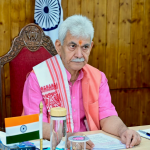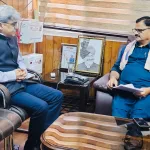World Heritage Week, observed globally from November 19 to November 25 each year, is a celebration of cultural diversity and a reminder of the importance of preserving our shared human heritage. In the context of India, a country steeped in history, tradition, and cultural richness, World Heritage Week takes on added significance. This week provides a platform to reflect on the importance of safeguarding and promoting India’s unique heritage for the benefit of present and future generations.
In conjunction with the G20 conference, instead of exhibiting the armed and economic supremacy, India sailed against the tide and released Two pamphlets, “Bharat: The Mother of Democracy” and “Elections in India,” which trace the origins of Indian democracy back to 6,000 BCE. The booklet refers to Vedas, Ramayana, Mahabharata, Arthashatra, and follows the history of democracy in the nation through the “Sindhu-Saraswati civilization,” or Harappan Civilization, and highlights the rule of Ashoka and Akbar, the Cholas and the Vijayanagar Empire, as well as the teachings of Megasthenes and Kautilya. The booklet is showcasing the illustrations of Dancing Girl from Mohenjo-Daro, the pages of ancient manuscripts, the art of Sanchi Stupa, the teachings of Buddhism, Jainism, Vedic philosophy, temples, etc. down the line from 6000 BCE to 18th Century CE.
The world leadership were showcased the rich cultural heritage and precious ancient ideas to bridge the nations through these shared narratives, hence Cultural and Heritage Diplomacy. The Cultural and heritage diplomacy is a powerful tool that nations wield to foster understanding, build bridges, and strengthen international relations. Unlike traditional diplomacy, which often focuses on political and economic interactions, cultural and heritage diplomacy centers around the promotion of a nation’s cultural assets and historical richness. This form of diplomacy recognizes the significance of shared narratives, arts, traditions, and heritage in creating lasting connections between people and nations.
Cultural diplomacy involves the exchange of cultural elements such as art, music, literature, and traditions between nations. It serves as a means to showcase a nation’s identity and values to the world. By sharing cultural expressions, countries can transcend linguistic and political barriers, fostering mutual respect and appreciation.
Heritage diplomacy, on the other hand, focuses on promoting a nation’s historical treasures and traditions. UNESCO plays a crucial role in this aspect, designating World Heritage Sites to recognize and protect cultural and natural landmarks of outstanding value. Nations often leverage these designations to enhance their global standing and attract tourism, showcasing the importance of preserving cultural heritage for the benefit of humanity.
The Taj Mahal in India, and the Pyramids of Egypt are examples of cultural and historical treasures that transcend national boundaries. These iconic sites serve as symbols of human achievement, connecting people across time and space. Nations that invest in preserving and promoting their heritage contribute not only to their own cultural identity but also to the collective heritage of humanity.
Several nations actively engage in cultural and heritage diplomacy to strengthen their international ties. For instance, France’s Alliance Française promotes French language and culture globally, fostering a network of cultural exchange and understanding. Similarly, Spain’s Cervantes Institute works to promote the Spanish language and Hispanic culture worldwide. Moreover, international festivals, such as the Edinburgh Festival in Scotland or the Carnival in Rio de Janeiro, provide platforms for countries to showcase their cultural richness and diversity. These events attract a global audience, facilitating cultural exchange and dialogue.
While cultural and heritage diplomacy can be a powerful force for building connections, it is not without challenges. Nations must navigate the delicate balance between promoting their own culture and respecting the diversity of others. Additionally, political tensions or conflicts can impact cultural exchange initiatives, requiring careful navigation to maintain open channels of communication.
In the digital age, technology has opened up new opportunities for cultural and heritage diplomacy. Virtual museums, online exhibitions, and digital platforms enable people from around the world to engage with cultural content without physical boundaries. Social media also plays a significant role, allowing nations to share their cultural narratives directly with a global audience.
India is a land of incredible diversity, boasting a rich tapestry of cultural, historical, and natural heritage. From the ancient temples of Khajuraho to the majestic forts of Rajasthan, from the serene backwaters of Kerala to the architectural wonders of Hampi, India’s heritage is a testament to the creativity, innovation, and resilience of its people through the ages. The country is home to 42 UNESCO World Heritage Sites, each representing a unique facet of India’s multifaceted identity. These sites include historical monuments, natural wonders, and cultural landscapes that have stood the test of time, narrating stories of India’s past and shaping its present.
However, the story in the Valley of Kashmir is vice-versa. Out of seventy documented Neolithic sites only 3 are excavated and none preserved, number of ancient temples and Khanqas exist without any measures of professional conservation, new surveys and explorations are on the halt. The collections in the museums are waiting for chance finds, the documentation of intangible and tangible heritage is limited to private authors and researchers.
Therefore, this World Heritage Week serves as an opportunity to raise awareness about the importance of preserving cultural and natural heritage. Educational programs, workshops, and cultural events to be organized across the country to engage people in understanding the significance of these sites and the need for their conservation.
This week encourages government bodies, conservationists, and local communities to come together in their commitment to preserving and safeguarding Kashmir’s heritage. It serves as a reminder that the responsibility of protecting these treasures falls on the collective shoulders of society.
World Heritage Week is also a time for celebrating Kashmir’s rich cultural heritage. Festivals, exhibitions, and cultural performances showcase the diversity of traditions and practices that make India unique. This celebration not only fosters a sense of pride but also encourages a deeper understanding and appreciation of the country’s heritage.
The work to the recognition of heritage sites as World Heritage Sites in Kashmir should be started; it not only brings prestige to the region and the country but also boosts tourism. Visitors from around the world are drawn to these sites, contributing to the local economy and creating opportunities for sustainable tourism practices.
The challenges of preserving the archaeological and heritage sites and monuments are manifold. Human greed, population pressure, constructions, urbanization, pollution, and climate change pose threats to the integrity of these invaluable treasures. World Heritage Week provides a platform to address these challenges, encouraging discussions on sustainable development and responsible tourism in the valley.
World Heritage Week in Kashmir should not be just a celebration; it is a call to action. It invites individuals, communities, and the government to come together to ensure the protection and promotion of India’s rich cultural heritage. We should look towards the future, the significance of World Heritage Week lies in its ability to inspire a collective commitment to preserving the stories, traditions, and landmarks that define our identity on the global stage. By recognizing the value of our shared heritage, we pave the way for a legacy that transcends time and connects generations.
It will help in participating in the cultural diplomacy of our country that serves as a bridge between nations, fostering understanding, respect, and collaboration. By recognizing the importance of shared narratives, traditions, and historical treasures, countries can build lasting connections that transcend political differences. As we navigate an increasingly interconnected world, cultural and heritage diplomacy stands out as a vital tool for shaping a global community built on mutual appreciation and dialogue.
(Author is ICHR Research Fellow and can be reached at: [email protected])





